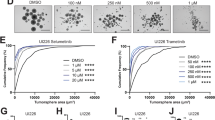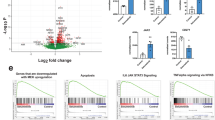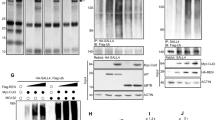Abstract
Medulloblastoma (MB) is a highly malignant brain tumor that occurs primarily in children. Although surgery, radiation and high-dose chemotherapy have led to increased survival, many MB patients still die from their disease, and patients who survive suffer severe long-term side effects as a consequence of treatment. Thus, more effective and less toxic therapies for MB are critically important. Development of such therapies depends in part on identification of genes that are necessary for growth and survival of tumor cells. Survivin is an inhibitor of apoptosis protein that regulates cell cycle progression and resistance to apoptosis, is frequently expressed in human MB and when expressed at high levels predicts poor clinical outcome. Therefore, we hypothesized that Survivin may have a critical role in growth and survival of MB cells and that targeting it may enhance MB therapy. Here we show that Survivin is overexpressed in tumors from patched (Ptch) mutant mice, a model of Sonic hedgehog (SHH)-driven MB. Genetic deletion of survivin in Ptch mutant tumor cells significantly inhibits proliferation and causes cell cycle arrest. Treatment with small-molecule antagonists of Survivin impairs proliferation and survival of both murine and human MB cells. Finally, Survivin antagonists impede growth of MB cells in vivo. These studies highlight the importance of Survivin in SHH-driven MB, and suggest that it may represent a novel therapeutic target in patients with this disease.
This is a preview of subscription content, access via your institution
Access options
Subscribe to this journal
Receive 50 print issues and online access
$259.00 per year
only $5.18 per issue
Buy this article
- Purchase on Springer Link
- Instant access to full article PDF
Prices may be subject to local taxes which are calculated during checkout







Similar content being viewed by others
References
Packer RJ, Cogen P, Vezina G, Rorke LB . Medulloblastoma: clinical and biologic aspects. Neuro-Oncology 1999; 1: 232–250.
Packer RJ, Vezina G . Management of and prognosis with medulloblastoma: therapy at a crossroads. Arch Neurol 2008; 65: 1419–1424.
Fossati P, Ricardi U, Orecchia R . Pediatric medulloblastoma: toxicity of current treatment and potential role of protontherapy. Cancer Treat Rev 2009; 35: 79–96.
Northcott PA, Dubuc AM, Pfister S, Taylor MD . Molecular subgroups of medulloblastoma. Expert Rev Neurotherap 2012; 12: 871–884.
Rudin CM, Hann CL, Laterra J, Yauch RL, Callahan CA, Fu L et al. Treatment of medulloblastoma with hedgehog pathway inhibitor GDC-0449. N Engl J Med 2009; 361: 1173–1178.
Amakye D, Jagani Z, Dorsch M . Unraveling the therapeutic potential of the Hedgehog pathway in cancer. Nat Med 2013; 19: 1410–1422.
Kool M, Jones DT, Jager N, Northcott PA, Pugh TJ, Hovestadt V et al. Genome sequencing of SHH medulloblastoma predicts genotype-related response to smoothened inhibition. Cancer Cell 2014; 25: 393–405.
Altieri DC . Survivin, cancer networks and pathway-directed drug discovery. Nat Rev Cancer 2008; 8: 61–70.
Wheatley SP, McNeish IA . Survivin: a protein with dual roles in mitosis and apoptosis. Int Rev Cytol 2005; 247: 35–88.
Huang LN, Wang DS, Chen YQ, Zhao CL, Gong BL, Jiang AB et al. Expression of survivin and patients survival in non-small cell lung cancer: a meta-analysis of the published studies. Mol Biol Rep 2013; 40: 917–924.
Yamashita S, Masuda Y, Kurizaki T, Haga Y, Murayama T, Ikei S et al. Survivin expression predicts early recurrence in early-stage breast cancer. Anticancer Res 2007; 27: 2803–2808.
Park E, Gang EJ, Hsieh YT, Schaefer P, Chae S, Klemm L et al. Targeting survivin overcomes drug resistance in acute lymphoblastic leukemia. Blood 2011; 118: 2191–2199.
Adida C, Recher C, Raffoux E, Daniel MT, Taksin AL, Rousselot P et al. Expression and prognostic significance of survivin in de novo acute myeloid leukaemia. Br J Haematol 2000; 111: 196–203.
Fangusaro JR, Caldas H, Jiang Y, Altura RA . Survivin: an inhibitor of apoptosis in pediatric cancer. Pediatr Blood Cancer 2006; 47: 4–13.
Shirai K, Suzuki Y, Oka K, Noda SE, Katoh H, Itoh J et al. Nuclear survivin expression predicts poorer prognosis in glioblastoma. J Neuro-Oncol 2009; 91: 353–358.
Adida C, Crotty PL, McGrath J, Berrebi D, Diebold J, Altieri DC . Developmentally regulated expression of the novel cancer anti-apoptosis gene survivin in human and mouse differentiation. Am J Pathol 1998; 152: 43–49.
Carrasco RA, Stamm NB, Marcusson E, Sandusky G, Iversen P, Patel BK . Antisense inhibition of survivin expression as a cancer therapeutic. Mol Cancer Therap 2011; 10: 221–232.
Ling X, Cao S, Cheng Q, Keefe JT, Rustum YM, Li F . A novel small molecule FL118 that selectively inhibits survivin, Mcl-1, XIAP and cIAP2 in a p53-independent manner, shows superior antitumor activity. PLoS ONE 2012; 7: e45571.
Nagaraj S, Pisarev V, Kinarsky L, Sherman S, Muro-Cacho C, Altieri DC et al. Dendritic cell-based full-length survivin vaccine in treatment of experimental tumors. J Immunother 2007; 30: 169–179.
Nakahara T, Yamanaka K, Hatakeyama S, Kita A, Takeuchi M, Kinoyama I et al. YM155, a novel survivin suppressant, enhances taxane-induced apoptosis and tumor regression in a human Calu 6 lung cancer xenograft model. Anti-cancer Drugs 2011; 22: 454–462.
Zhu K, Qin H, Cha SC, Neelapu SS, Overwijk W, Lizee GA et al. Survivin DNA vaccine generated specific antitumor effects in pancreatic carcinoma and lymphoma mouse models. Vaccine 2007; 25: 7955–7961.
Tolcher AW, Quinn DI, Ferrari A, Ahmann F, Giaccone G, Drake T et al. A phase II study of YM155, a novel small-molecule suppressor of survivin, in castration-resistant taxane-pretreated prostate cancer. Ann Oncol 2012; 23: 968–973.
Becker JC, Andersen MH, Hofmeister-Muller V, Wobser M, Frey L, Sandig C et al. Survivin-specific T-cell reactivity correlates with tumor response and patient survival: a phase-II peptide vaccination trial in metastatic melanoma. Cancer Immunol Immunother 2012; 61: 2091–2103.
Lewis KD, Samlowski W, Ward J, Catlett J, Cranmer L, Kirkwood J et al. A multi-center phase II evaluation of the small molecule survivin suppressor YM155 in patients with unresectable stage III or IV melanoma. Invest N Drugs 2011; 29: 161–166.
Tanioka M, Nokihara H, Yamamoto N, Yamada Y, Yamada K, Goto Y et al. Phase I study of LY2181308, an antisense oligonucleotide against survivin, in patients with advanced solid tumors. Cancer Chemother Pharmacol 2011; 68: 505–511.
Talbot DC, Ranson M, Davies J, Lahn M, Callies S, Andre V et al. Tumor survivin is downregulated by the antisense oligonucleotide LY2181308: a proof-of-concept, first-in-human dose study. Clin Cancer Res 2010; 16: 6150–6158.
Haberler C, Slavc I, Czech T, Gelpi E, Heinzl H, Budka H et al. Histopathological prognostic factors in medulloblastoma: high expression of survivin is related to unfavourable outcome. Eur J Cancer 2006; 42: 2996–3003.
Fangusaro JR, Jiang Y, Holloway MP, Caldas H, Singh V, Boue DR et al. Survivin, Survivin-2B, and Survivin-deItaEx3 expression in medulloblastoma: biologic markers of tumour morphology and clinical outcome. Br J Cancer 2005; 92: 359–365.
Li XN, Shu Q, Su JM, Adesina AM, Wong KK, Perlaky L et al. Differential expression of survivin splice isoforms in medulloblastomas. Neuropathol Appl Neurobiol 2007; 33: 67–76.
Yang ZJ, Ellis T, Markant SL, Read TA, Kessler JD, Bourboulas M et al. Medulloblastoma can be initiated by deletion of Patched in lineage-restricted progenitors or stem cells. Cancer Cell 2008; 14: 135–145.
Xing Z, Conway EM, Kang C, Winoto A . Essential role of survivin, an inhibitor of apoptosis protein, in T cell development, maturation, and homeostasis. J Exp Med 2004; 199: 69–80.
Nakahara T, Takeuchi M, Kinoyama I, Minematsu T, Shirasuna K, Matsuhisa A et al. YM155, a novel small-molecule survivin suppressant, induces regression of established human hormone-refractory prostate tumor xenografts. Cancer Res 2007; 67: 8014–8021.
Berezov A, Cai Z, Freudenberg JA, Zhang H, Cheng X, Thompson T et al. Disabling the mitotic spindle and tumor growth by targeting a cavity-induced allosteric site of survivin. Oncogene 2012; 31: 1938–1948.
Guvenc H, Pavlyukov MS, Joshi K, Kurt H, Banasavadi-Siddegowda YK, Mao P et al. Impairment of glioma stem cell survival and growth by a novel inhibitor for Survivin-Ran protein complex. Clin Cancer Res 2013; 19: 631–642.
Blomstrand M, Brodin NP, Munck Af Rosenschold P, Vogelius IR, Sanchez Merino G, Kiil-Berthlesen A et al. Estimated clinical benefit of protecting neurogenesis in the developing brain during radiation therapy for pediatric medulloblastoma. Neuro-Oncology 2012; 14: 882–889.
Mulhern RK, Palmer SL, Merchant TE, Wallace D, Kocak M, Brouwers P et al. Neurocognitive consequences of risk-adapted therapy for childhood medulloblastoma. J Clin Oncol 2005; 23: 5511–5519.
Iwasa T, Okamoto I, Suzuki M, Nakahara T, Yamanaka K, Hatashita E et al. Radiosensitizing effect of YM155, a novel small-molecule survivin suppressant, in non-small cell lung cancer cell lines. Clin Cancer Res 2008; 14: 6496–6504.
Pan S, Wu X, Jiang J, Gao W, Wan Y, Cheng D et al. Discovery of NVP-LDE225, a potent and selective smoothened antagonist. ACS Med Chem Lett 2010; 1: 130–134.
Rodon J, Tawbi HA, Thomas AL, Stoller RG, Turtschi CP, Baselga J et al. A phase I, multicenter, open-label, first-in-human, dose-escalation study of the oral smoothened inhibitor Sonidegib (LDE225) in patients with advanced solid tumors. Clin Cancer Res 2014; 20: 1900–1909.
Markant SL, Esparza LA, Sun J, Barton KL, McCoig LM, Grant GA et al. Targeting sonic hedgehog-associated medulloblastoma through inhibition of Aurora and Polo-like kinases. Cancer Res 2013; 73: 6310–6322.
Zhao X, Liu Z, Yu L, Zhang Y, Baxter P, Voicu H et al. Global gene expression profiling confirms the molecular fidelity of primary tumor-based orthotopic xenograft mouse models of medulloblastoma. Neuro-Oncology 2012; 14: 574–583.
Minematsu T, Sonoda T, Hashimoto T, Iwai M, Oppeneer T, Felder L et al. Pharmacokinetics, distribution and excretion of YM155 monobromide, a novel small-molecule survivin suppressant, in male and pregnant or lactating female rats. Biopharm Drug Dispos 2012; 33: 160–169.
Nakahara T, Kita A, Yamanaka K, Mori M, Amino N, Takeuchi M et al. Broad spectrum and potent antitumor activities of YM155, a novel small-molecule survivin suppressant, in a wide variety of human cancer cell lines and xenograft models. Cancer Sci 2011; 102: 614–621.
Ruchaud S, Carmena M, Earnshaw WC . Chromosomal passengers: conducting cell division. Nat Rev Mol Cell Biol 2007; 8: 798–812.
Yue Z, Carvalho A, Xu Z, Yuan X, Cardinale S, Ribeiro S et al. Deconstructing Survivin: comprehensive genetic analysis of Survivin function by conditional knockout in a vertebrate cell line. J Cell Biol 2008; 183: 279–296.
Saito T, Hama S, Izumi H, Yamasaki F, Kajiwara Y, Matsuura S et al. Centrosome amplification induced by survivin suppression enhances both chromosome instability and radiosensitivity in glioma cells. Br J Cancer 2008; 98: 345–355.
Rosa J, Canovas P, Islam A, Altieri DC, Doxsey SJ . Survivin modulates microtubule dynamics and nucleation throughout the cell cycle. Mol Biol Cell 2006; 17: 1483–1493.
Arora R, Shuda M, Guastafierro A, Feng H, Toptan T, Tolstov Y et al. Survivin is a therapeutic target in Merkel cell carcinoma. Sci Transl Med 2012; 4: 133ra56.
Yamauchi T, Nakamura N, Hiramoto M, Yuri M, Yokota H, Naitou M et al. Sepantronium bromide (YM155) induces disruption of the ILF3/p54(nrb) complex, which is required for survivin expression. Biochem Biophys Res Commun 2012; 425: 711–716.
Nakamura N, Yamauchi T, Hiramoto M, Yuri M, Naito M, Takeuchi M et al. Interleukin enhancer-binding factor 3/NF110 is a target of YM155, a suppressant of survivin. Mol Cell Proteom 2012; 11: M111 013243.
Cheng Q, Ling X, Haller A, Nakahara T, Yamanaka K, Kita A et al. Suppression of survivin promoter activity by YM155 involves disruption of Sp1-DNA interaction in the survivin core promoter. Int J Biochem Mol Biol 2012; 3: 179–197.
Tao YF, Lu J, Du XJ, Sun LC, Zhao X, Peng L et al. Survivin selective inhibitor YM155 induce apoptosis in SK-NEP-1 Wilms tumor cells. BMC Cancer 2012; 12: 619.
Grinstein E, Jundt F, Weinert I, Wernet P, Royer HD . Sp1 as G1 cell cycle phase specific transcription factor in epithelial cells. Oncogene 2002; 21: 1485–1492.
Chakravarti A, Zhai GG, Zhang M, Malhotra R, Latham DE, Delaney MA et al. Survivin enhances radiation resistance in primary human glioblastoma cells via caspase-independent mechanisms. Oncogene 2004; 23: 7494–7506.
Morrison DJ, Hogan LE, Condos G, Bhatla T, Germino N, Moskowitz NP et al. Endogenous knockdown of survivin improves chemotherapeutic response in ALL models. Leukemia 2012; 26: 271–279.
Yamanaka K, Nakahara T, Yamauchi T, Kita A, Takeuchi M, Kiyonaga F et al. Antitumor activity of YM155, a selective small-molecule survivin suppressant, alone and in combination with docetaxel in human malignant melanoma models. Clin Cancer Res 2011; 17: 5423–5431.
Olie RA, Simoes-Wust AP, Baumann B, Leech SH, Fabbro D, Stahel RA et al. A novel antisense oligonucleotide targeting survivin expression induces apoptosis and sensitizes lung cancer cells to chemotherapy. Cancer Res 2000; 60: 2805–2809.
Grossman D, Altieri DC . Drug resistance in melanoma: mechanisms, apoptosis, and new potential therapeutic targets. Cancer Metast Rev 2001; 20: 3–11.
Rodel F, Frey B, Leitmann W, Capalbo G, Weiss C, Rodel C . Survivin antisense oligonucleotides effectively radiosensitize colorectal cancer cells in both tissue culture and murine xenograft models. Int J Radiat Oncol Biol Phys 2008; 71: 247–255.
Okamoto K, Okamoto I, Hatashita E, Kuwata K, Yamaguchi H, Kita A et al. Overcoming erlotinib resistance in EGFR mutation-positive non-small cell lung cancer cells by targeting survivin. Mol Cancer Therap 2012; 11: 204–213.
Hall WA, Sherr GT . Convection-enhanced delivery of targeted toxins for malignant glioma. Expert Opin Drug Deliv 2006; 3: 371–377.
Kunwar S, Prados MD, Chang SM, Berger MS, Lang FF, Piepmeier JM et al. Direct intracerebral delivery of cintredekin besudotox (IL13-PE38QQR) in recurrent malignant glioma: a report by the Cintredekin Besudotox Intraparenchymal Study Group. J Clin Oncol 2007; 25: 837–844.
Brown MT, Coleman RE, Friedman AH, Friedman HS, McLendon RE, Reiman R et al. Intrathecal 131I-labeled antitenascin monoclonal antibody 81C6 treatment of patients with leptomeningeal neoplasms or primary brain tumor resection cavities with subarachnoid communication: phase I trial results. Clin Cancer Res 1996; 2: 963–972.
Serwer LP, James CD . Challenges in drug delivery to tumors of the central nervous system: an overview of pharmacological and surgical considerations. Adv Drug Deliv Rev 2012; 64: 590–597.
Ellis T, Smyth I, Riley E, Graham S, Elliot K, Narang M et al. Patched 1 conditional null allele in mice. Genesis 2003; 36: 158–161.
Machold R, Fishell G . Math1 is expressed in temporally discrete pools of cerebellar rhombic-lip neural progenitors. Neuron 2005; 48: 17–24.
Goodrich LV, Milenkovic L, Higgins KM, Scott MP . Altered neural cell fates and medulloblastoma in mouse patched mutants. Science 1997; 277: 1109–1113.
Oliver TG, Read TA, Kessler JD, Mehmeti A, Wells JF, Huynh TT et al. Loss of patched and disruption of granule cell development in a pre-neoplastic stage of medulloblastoma. Development 2005; 132: 2425–2439.
Acknowledgements
We appreciate the support of the Sanford-Burnham Shared Resources, including Amy Cortez, Jonna Hurtado and Yoav Altman (Flow Cytometry); Robbin Newlin (Histopathology); Danielle McAnally, Michael Vicchiarelli and Arianna Mangravita-Novo (Chemical Genomics); Lili Lacarra, Adriana Charbono and Kenny Venegas (Animal facility); and Anthony Pinkerton and members of the Medicinal Chemistry Resource for generation of S12 and LLP3. We are also grateful to Ana Miletic-Sedy and Robert Rickert for sharing Survivinfl/fl mice; and to Robert Margolis for helpful discussions. We thank the Flanders Institute for Biotechnology (VIB), Belgium, for allowing us to use the Survivinfl/fl mice. EMC is supported by grants from the Canadian Institutes for Health Research (CIHR), the Natural Sciences and Engineering Research Council of Canada (NSERC). He holds a Tier 1 Canada Research Chair (CRC) in Endothelial Cell Biology. MIG is supported by Grant 5R01CA08948. This work was supported by NCI award number 5P30CA030199 and R01 CA122759 and by the Cedars-Sinai/Sanford-Burnham Grant Program for Cancer Research. RWR is the recipient of a Research Leadership Award from the California Institute for Regenerative Medicine (CIRM LA1-01747).
Author information
Authors and Affiliations
Corresponding author
Ethics declarations
Competing interests
The authors declare no conflict of interest.
Additional information
Supplementary Information accompanies this paper on the Oncogene website
Rights and permissions
About this article
Cite this article
Brun, S., Markant, S., Esparza, L. et al. Survivin as a therapeutic target in Sonic hedgehog-driven medulloblastoma. Oncogene 34, 3770–3779 (2015). https://doi.org/10.1038/onc.2014.304
Received:
Revised:
Accepted:
Published:
Issue Date:
DOI: https://doi.org/10.1038/onc.2014.304
This article is cited by
-
Targeting the apoptosis pathway to treat tumours of the paediatric nervous system
Cell Death & Disease (2022)
-
BIRC3 and BIRC5: multi‐faceted inhibitors in cancer
Cell & Bioscience (2021)
-
A tetrahedral DNA nanoflare for fluorometric determination of nucleic acids and imaging of microRNA using toehold strands
Microchimica Acta (2019)
-
Downregulation of Survivin Gene Expression Affects Ionizing Radiation Resistance of Human T98 Glioma Cells
Cellular and Molecular Neurobiology (2018)
-
Multidimensional integrative analysis uncovers driver candidates and biomarkers in penile carcinoma
Scientific Reports (2017)



